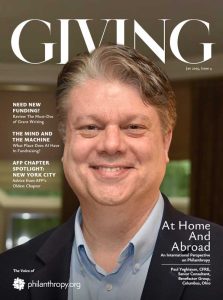
Paul Yeghiayan, CFRE
Senior Consultant
Benefactor Group
Columbus, Ohio

Spending time as a youth abroad, what were some of your earliest encounters with philanthropy, and how did they shape your perspective on giving and nonprofit work?
My earliest childhood memories were from my time with family in Ethiopia. My great-grandfather, a dentist and political prisoner, escaped pogroms in the late 1890s in what was then the Ottoman Empire, now Turkey. He moved to Ethiopia, where he opened a dental practice and served the royal family.
My grandmother, his daughter, was baptized in the Armenian Apostolic Church and, at Emperor Menelik’s request, in the Ethiopian Coptic Church, with Empress Zewditu and then-Prince Haile Selassie as her godparents. She was baptized as Princess Tsetalemariam, meaning “morning star,” and considered part of the royal family.
This relationship extended for decades and positioned my family—and later many Armenians, most of whom were survivors of the Armenian Genocide, including my grandfather—to find refuge in Ethiopia. Armenians contributed skills in government, medicine, construction, commerce, and the arts.
My father’s family had long been involved in philanthropy, opening free pharmacies and education initiatives. My father, a U.S.-trained attorney, later served as Special Assistant for International Operations for ACTION, a U.S. federal agency coordinating domestic and international volunteer programs. My mother’s family, who escaped genocide from Istanbul to Cairo, were educators, artists, and musicians and remained long-time supporters of the arts and education.
From a young age, I became acutely aware of poverty, hunger, and the unevenness of the human condition. Witnessing significant relief efforts shaped my perspective—it was never an academic exercise. Charitable work has been a core family and personal value, made possible by the generosity of those who provided refuge and kindness to victims of horrific human crimes.
What inspired you to pursue a career in fundraising, and how did those early influences guide your approach?
I was involved in fundraising informally from an early age, collecting for UNICEF and distributing food and clothing at shelters. In my late 20s, when my best friend contracted leukemia, I became more engaged in community giving, organizing blood drives and fundraising for research. After his passing, I pursued a graduate degree and began working full-time in fundraising, starting with reforestation and environmental initiatives in Armenia.
I then worked as a philanthropy officer for Heifer International, launched a public health foundation in Washington, D.C., and helped build a fundraising infrastructure for a university in Armenia. For the past eight years, I’ve worked in consulting.
My experiences make me well-suited for nonprofit consulting, where I can help multiple organizations impartially. I’m known as a no-nonsense strategic thinker, steady amid chaos—an ever-present reality in nonprofits. My focus has shifted toward deferred and estate giving, the most technically challenging yet personal form of charitable giving. In my heart, I am a major and principal gifts officer, helping organizations build trust-based donor relationships.
How do you ensure authenticity and impact when telling stories of transformation from different regions?
Authentic, impactful storytelling is the heart of fundraising. Ethical stories must resonate while honoring the dignity of those showcased. That requires cultural sensitivity, humility, and genuine curiosity.
Authenticity comes when communities tell their own stories rather than imposing external narratives. For example, I launched a women-in-STEM scholarship endowment at an Armenian university. Before crafting stories, I interviewed 23 female students about their challenges. I assumed they faced discouragement in STEM, but I quickly learned that wasn’t true—their families and communities encouraged them. Their real challenge was financial access. Had I relied on my assumptions, I would have misrepresented their reality and portrayed them as victims rather than ambitious individuals enabled by donors.
Centering local voices is crucial. Partnering with local storytellers ensures narratives are accurate and culturally respectful. Instead of saying, “This is what we’ve done for them,” a campaign should highlight the resilience and commitment of the community itself.
Understanding the audience is just as important. Major donors may resonate with sustainability and impact, grassroots donors with personal, human-centered stories, and corporate partners with alignment to systemic change. The same story can be framed differently while preserving its core truth. Regardless of location, stories should emphasize universal values like resilience, hope, and community. While specifics vary, shared sentiments inspire generosity across cultures.
What advice would you give to someone building a nonprofit in a new or unfamiliar region?
Launching a nonprofit in a new region requires understanding the local ecosystem, building strong relationships, and adopting a sound funding strategy. Start with a thorough community needs assessment—assume nothing, ask questions, and be willing to make mistakes. Engage local leaders, business owners, and nonprofits. Align yourself with local values and priorities rather than imposing external solutions.
Corruption exists in many regions, from petty bribes to extortion. Define your risk tolerance and understand that Western business models may not apply.
Financial stability is a major challenge, so be clear on your funding sources. Focus early efforts on founding donors, capacity-building grants, and corporate sponsorships. Demonstrate impact quickly through pilot programs to attract credibility and refine initiatives before scaling.
Your operational systems must be sound from the start—set up a CRM correctly, track impact metrics, and prioritize transparency. Integrity is paramount—don’t mislead supporters. Build a reputation by doing what you say and ensuring local support for your projects.
Success hinges on adapting to feedback. Hiring local staff and empowering regional leaders fosters deeper connections. Establishing an advisory board of respected community members strengthens local buy-in. Above all, remain humble and committed to authentic, data-informed decision-making.
What lessons have you learned about resilience in fundraising that others can apply?
Fundraising resilience isn’t just about external obstacles—it’s about navigating internal challenges with adaptability, emotional intelligence, and a long-term vision. Many fundraising struggles stem from financial misalignment, logistical inefficiencies, or cultural resistance to philanthropy.
Make allies with the CFO. If they see fundraising as an expense rather than an investment, success will be difficult. I learned this the hard way—shifting an adversarial relationship into a collaborative one helped secure leadership buy-in and allowed me to focus on donors.
Fundraising should be built on strong systems rather than reactive solutions. Invest in donor management tools, standard stewardship plans, and cross-training to prevent knowledge loss.
Cultural resistance can also be a challenge. Many organizations operate with a scarcity mindset, fear of major gifts, or resistance to philanthropy. Fundraisers can drive change by engaging leadership, board members, and staff in fundraising efforts. Storytelling is a powerful tool—encouraging program staff to share impact stories strengthens the connection between fundraising and mission delivery.
Emotional resilience is also key. Fundraising involves rejection, delays, and shifting priorities. A strong fundraiser separates personal worth from outcomes, analyzes setbacks, and refines approaches rather than internalizing failures.
A mistake I regret is allowing poor treatment from leadership to affect my team. Taking care of oneself is crucial—not just for personal well-being, but for influencing team morale and donor relationships.
Fundraisers must embrace leadership, even without formal authority. Strong data, storytelling, and relationships can drive internal change, creating a donor- and community-centric culture.
What’s your advice for nonprofits navigating a rapidly changing world?
As Jean-Baptiste Alphonse Karr wrote, “The more things change, the more they stay the same.” Nonprofits often chase the next big thing, but at its core, this is a relationship-driven field—technology can aid, but not replace, authentic donor engagement.
Intergenerational wealth transfer trends are crucial. Nonprofits should work with experts in tax-efficient giving and emphasize legacy gifts. Global giving is also shifting—philanthropy is growing in the Global South, and younger donors prioritize impact-driven initiatives.
Crowdfunding and giving circles, often led by women, decentralize philanthropy, empowering grassroots movements. At the same time, private foundations wield disproportionate power. Burdensome application and reporting requirements strain nonprofits, often keeping projects in perpetual pilot phases.
A controversial opinion: private foundations should have a 30–40-year sunset clause. Rather than hoarding assets, they should spend down or contribute to working charities. This would better serve their missions.
Looking back, what do you hope your work has contributed to philanthropy?
I’m proud that initiatives I started years ago continue helping people. While I acknowledge my mortality, my best contributions are ahead.
I hope my work—rooted in collaboration, co-creation, and humble inquiry—inspires others to adopt similar approaches. A colleague recently told me I’ve influenced their firm’s shift toward trust-based philanthropy and community-led practices. I’ve never followed trends; I simply pursue practical, balanced solutions. Diplomacy is the heart of fundraising. There’s still much work ahead.